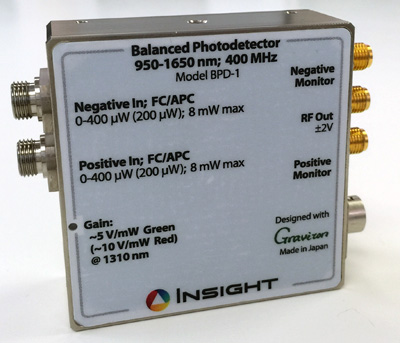High Performance Balanced Photodetector (BPD-1)
|
 |
|
|
The BPD-1 differential photodetector is a DC to 400 MHz dual balanced photodetector optimized for swept source OCT (SS-OCT) imaging systems. By careful design, the BPD-1 supports high speed SS-OCT, minimizing factors that other detectors do not even specify, such as harmonic distortion and group delay. Importantly, with high speed and low noise applications such as with new generation lasers, the laser noise can be an order of magnitude below older lasers, so the detector may limit the overall system noise performance and resulting image quality. The NEP of less than 5 pW/Hz is exemplary, and is roughly 75% lower than comparable devices. Since signal levels in SS-OCT systems can vary from setup to setup, a selectable 5 V/mW or 10 V/mW gain can be selected with little performance impact. Selectable gain allows the signal level to be adjusted to maximize the use of the analog-to-digital conversion dynamic range, avoiding loss of effective bits of resolution. The BPD-1 is configured as a dual-balanced receiver by subtracting the two optical input signals from each other, resulting in the cancellation of common mode noise. Dual balanced detection allows small changes in the signal path to be extracted from the interfering noise floor. The detector consists of two balanced photodiodes and an ultra-low-noise, high-speed transimpedance amplifier. Matching the two photodiodes results in an excellent common mode rejection ratio (CMRR), leading to better noise reduction. The detector a balanced RF-output from the transimpedance amplifier, and the Monitor+ and Monitor- ports allow the response of each photodiode to be observed individually to verify performance of each leg independently. The detectors are fiber coupled with SMF-28 fiber, reducing the chance of image artifacts that can occur with detector coupling optics. Insight has worked with one of the world’s top analog design teams at Graviton in Japan to create the BPD-1. Graviton, and their founder and top designer, Nagatomo-san, have created some of the world’s best audio amplifiers for decades, Nagatomo has also built some of the world’s best photodetector devices, including precision devices up to 8 GHz. By careful attention to parts, layout, topology and design, critical factors such as parasitic capacitance is reduced by multiples, supporting overall performance substantially better than other devices. |
||



